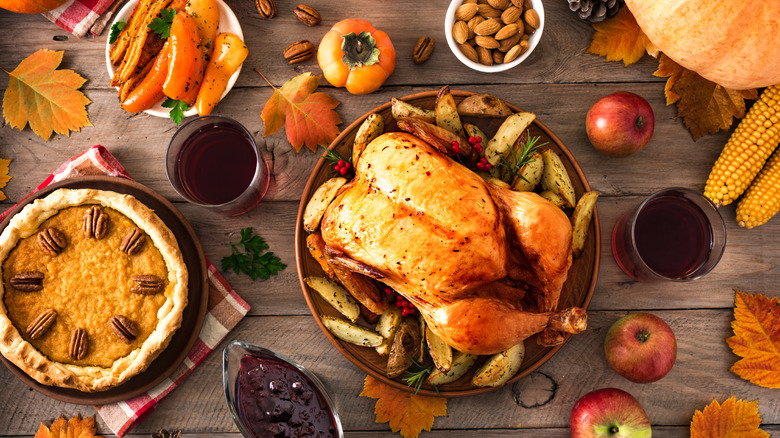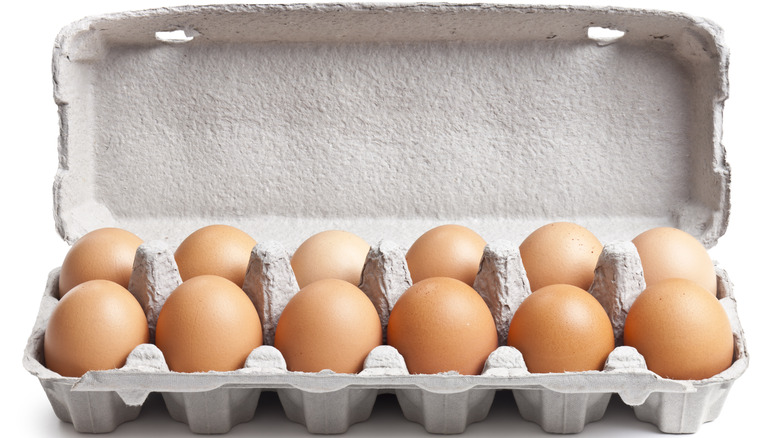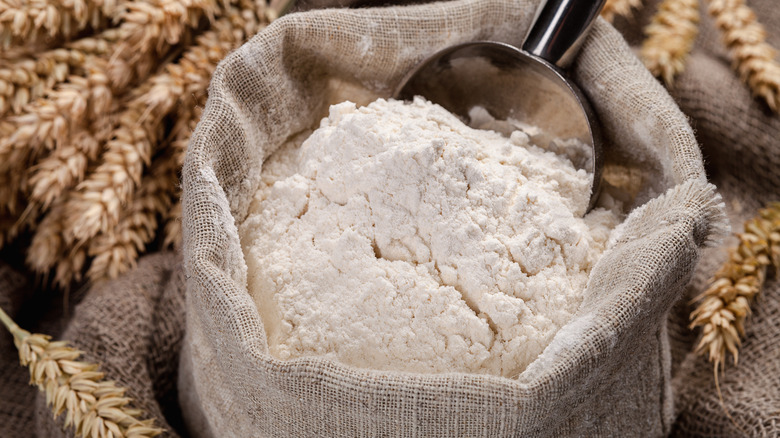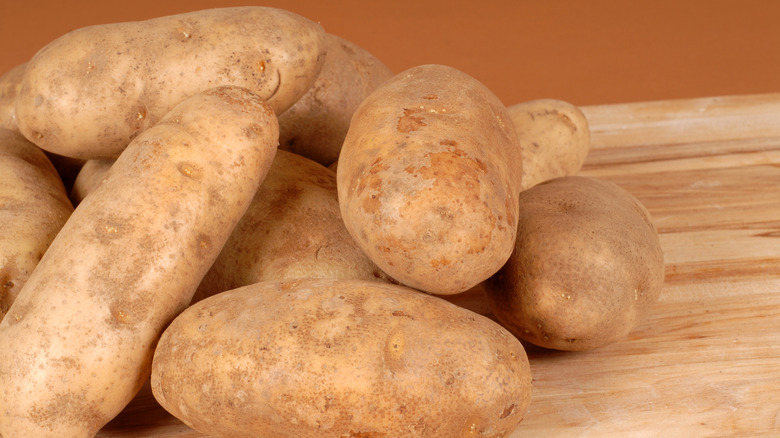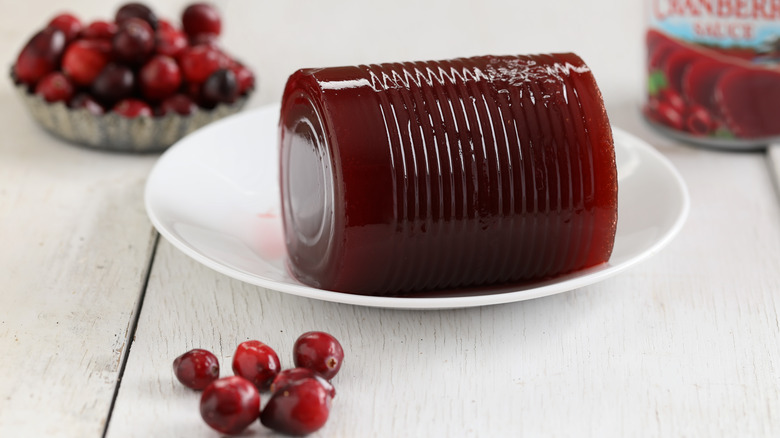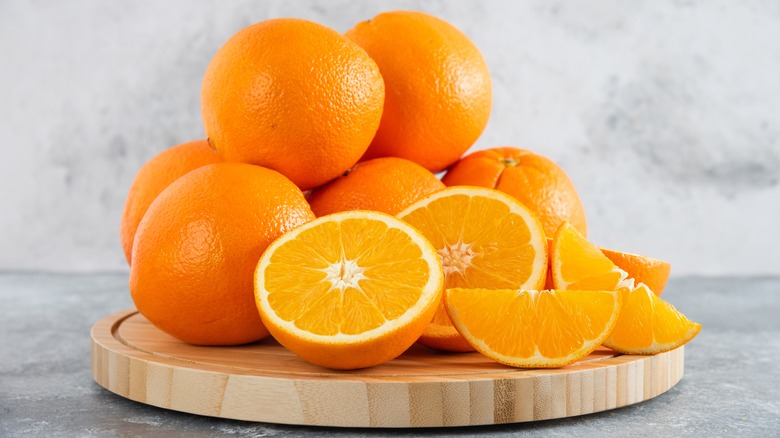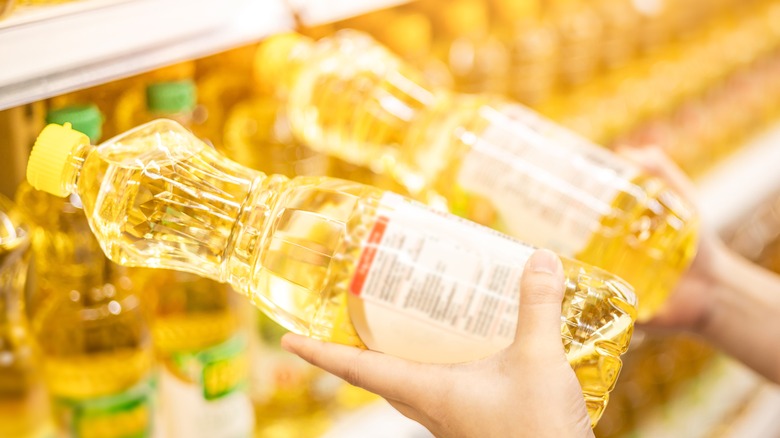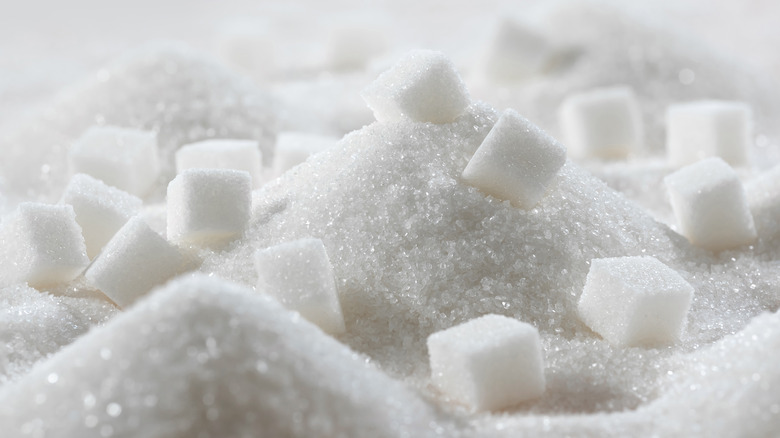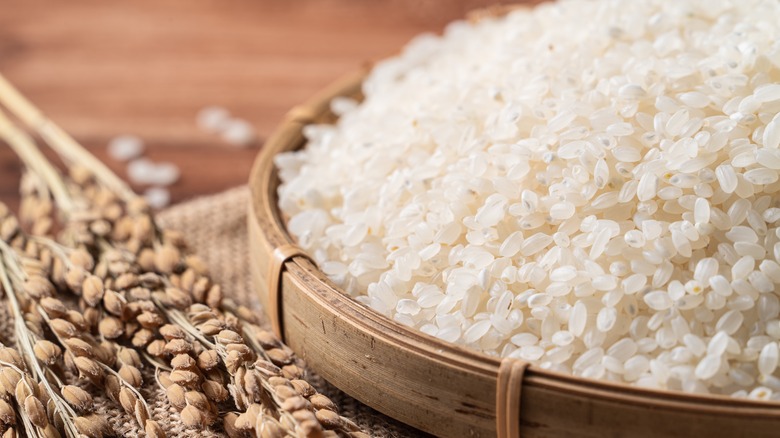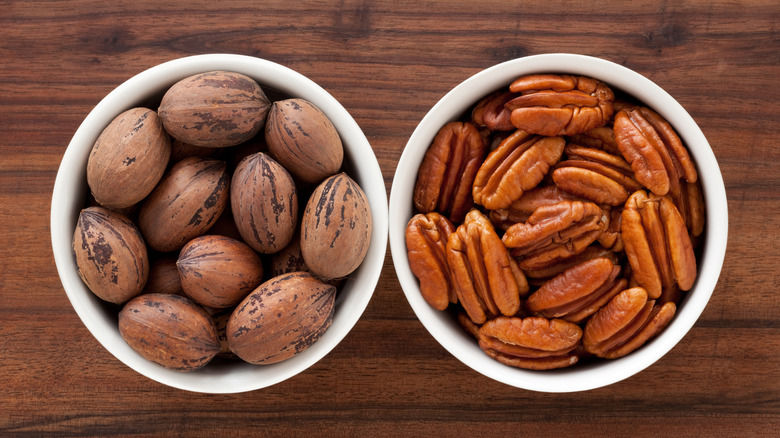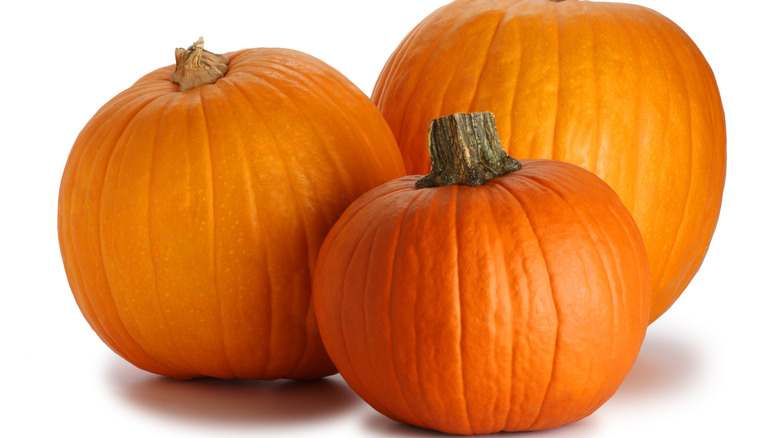Grocery Item Shortages You Can Expect For Thanksgiving 2023
A shortage of food brings to mind an image of empty grocery store shelves, something that the early months of the pandemic reinforced when the supply chain faltered. However, a shortage may also show up as inflation (think higher prices) due to tight supply. In either case, the result is that shoppers find it harder to obtain the foods they want, either because the items aren't available or because the prices have gone up too much. While not being able to buy what you want for the holidays isn't the end of the world, it can be a surprise if you didn't realize there was a problem with the supply to begin with.
Weather and disease can quickly affect how abundant a particular item is, and in 2023, the weather really showed its power. Droughts, heavy rains, excessive heat, hard freezes, and flooding all took their toll, and bird flu hasn't helped. Lingering supply-chain problems from the pandemic and the Ukraine-Russia war are also affecting how much food makes it from the field to your home. If you're planning on having a special Thanksgiving dinner this year, be ready for additional price hikes and possible difficulty getting some of these grocery items due to shortages.
Eggs
Again with the eggs. Do you remember back around December 2022 and January 2023, when the egg shortage due to avian influenza prompted prices to soar and led to empty shelves in grocery stores? And then producers did such a good job of increasing the supply that prices dropped back down? Well, that avian influenza outbreak is actually still going on. It's been affecting the supply and prices of eggs worldwide all year long. Whenever a flock is infected, producers cull the flock to stop the flu from spreading. Chickens usually don't recover from avian influenza, but they can spread it easily because the virus is very contagious, so killing off the flock is the only effective way to stop the virus from spreading to other chickens. That not only reduces the number of birds on a farm that can currently produce eggs, but it also creates a ripple effect that prolongs shortages as egg farmers need time to buy more uninfected chicks and let them grow to maturity while hatcheries are also dealing with their own outbreaks and having to cull their own flocks.
The current egg shortage is affecting prices in the U.S., but around the world, it's having more intense effects. In October 2023, a couple of South African retailers started rationing eggs due to the severe shortages there. If you can buy eggs without a limit this year, that's something to be thankful for.
Flour
Flour isn't new to the list of shortages. The war between Ukraine and Russia that started in 2022 limited the amount of wheat exported from the region and caused a global shortage. In the U.S., flour prices last year increased by over 17%. In 2023, the problem isn't the war, but rather the drought that much of the wheat-growing regions of the U.S. have experienced. In fact, the drought was so widespread that there have been some worries that flour will continue to be relatively scarce through 2024. However, the U.S. Department of Agriculture may have some good news, at least for future supplies: The October 2023 Wheat Report shows higher yields for several types of wheat. Just remember that processors need time to turn all that wheat into flour that you and manufacturers can buy.
Depending on the variety, wheat can take between 100 to 250 days to grow. After being harvested, the wheat is stored in grain elevators and then shipped out to mills after moisture in the grain reaches acceptable levels. That alone can take weeks. The mills clean and then condition the wheat to remove the bran and ensure even moisture levels, mix different wheats together for specific flour types, ground the wheat, sift it, package it, and ship it to stores or bakeries. This means that better harvests now might not help alleviate flour shortages for a while, and that could make any flour or bread you buy cost more for the time being.
Russet potatoes (possibly)
If you're a mashed potato fan, shop carefully. Potato crops, especially for russets, have had a few bad years. In 2022, the Pacific Northwest had an unusually cool spring, which Wells Fargo's Agri-Food Intelligence division said led to a delayed crop, and then a heat wave, which Wells Fargo said stunted plant growth. Combined with a smaller crop from 2021, the prediction was for potato prices to rise due to the resulting shortages.
But the cool spring and subsequent heat wave weren't the end of the potato crop's troubles. After that, a drought hit the region, further affecting supply. Prices in September were up 14% compared with a year earlier. In an interview with CNN, Michael Swanson, the chief agriculture economist for Wells Fargo, said that 2023 had a better crop and that this should help lower prices, although that assumes the crop will hit store shelves in time for the big holiday meal. However, Wells Fargo's 2023 Thanksgiving food report, released in November, hinted that consumers may still see quite a markup once these potatoes hit the stores as the spread between wholesale and retail prices hit record levels this year.
Cranberry sauce
Cranberries are another Thanksgiving item that hasn't had the best growing season in some regions. The berry was in short supply in 2022 due to weather causing poor crop quality; good-quality fresh berries were scarce and expensive, but canned cranberry sauce was much cheaper and easier to find because poor-quality berries could still be used for the canned stuff. Weather again hurt cranberry harvests across the country in 2023, with drought, excess snow, freezes, and hailstorms harming crops in many regions. As a result, yields in individual states were down anywhere from 5% to 12% compared to the already reduced yields of 2022.
For 2023's Thanksgiving meal, both fresh cranberries and canned cranberry sauce face a tough time. A truck driver shortage may affect transportation of berries from farms. The canned sauce has been affected by increasing labor and production costs. Wells Fargo predicts that the cost of fresh berries will still be lower than it was last year while canned sauce will cost substantially more.
Oranges and orange juice
Oranges may not seem like much of a Thanksgiving food, but a number of dishes like cranberry sauce and stuffing use orange juice in different variations of those recipes. Unfortunately, oranges and orange juice may be some of the worst-hit foods in terms of shortages during the Thanksgiving season this year. A combination of bad weather and a fatal citrus crop pathogen have hit orange crops in both Florida and California. While other states produce citrus, too, these are two of the top producers in the country, and the drop in yields in Florida has been astounding.
Hurricanes Ian and Nicole in 2022, a crop-killing frost at the beginning of January 2023, and a long-term battle with citrus greening disease have dealt Florida orange crops a huge blow. The 2023 harvest was forecast to be about 43% below what producers originally thought they'd be able to provide. In California, which has steadily increased its orange production each year, citrus greening disease has taken hold and is now affecting orchards. Florida also supplies upwards of 90% of the country's orange juice, so even with help from increased orange production in California, the supply of oranges and orange juice is going to be tight this season, and prices are already going up.
Cocoa and chocolate
In late 2017, a news story reported that the cacao bean could become extinct by 2050 due to climate change, a statement that many other news outlets picked up on with horror. Snopes thankfully debunked the claim, pointing out that the research that gave rise to the rumor was actually looking at ways to save the crop in two countries that were forecast to have a drop in available growing area. So, the worldwide existence of cacao plants was apparently safe, but that hasn't stopped the weather from affecting regional production year after year. That's created a cacao shortage that, while not as dire as the 2017 story implied, will still affect your Thanksgiving desserts.
Cacao plants need moisture in the form of rain and humidity, stable temperatures, and a good supply of nitrogen. Unfortunately, the climate in cacao-growing countries in Africa hasn't cooperated, leading to a weak crop and higher prices. Cocoa prices have soared 22% this year in the U.K., for example, and candy companies are reducing what they produce because of inflation. It may not seem like there's much of a chocolate shortage when you walk through a candy aisle at the store, but those prices will continue to rise due to the lower supply.
Almost every type of vegetable oil
Last year, there was an olive oil shortage due to extreme drought threatening olive trees in southwestern Europe, CNN reported. This year, cooking oil continues to be in short supply — and it looks like just about every type of vegetable oil is affected. Palm oil exports from Indonesia are down due to government restrictions, the Canadian canola crop is smaller than usual, the Ukraine-Russia war continues to limit the amount of sunflower oil available, and South American soybean oil production has been affected by drought. Another factor contributing to the shortage is the demand for vegetable oil for use in biofuels. The one bit of better news is that the forecast for U.S. soybean crops looks bright.
With all these oils in shorter supply, higher prices will likely be an issue. You may want to look at alternative oils for cooking and baking so that you have more of a choice. Before you substitute one oil for another, though, remember to look at smoke points and whether the oil will change the flavor of the item you're cooking.
Sugar
Globally, the sugar industry's been hit by a combination of bad weather, rising prices for supplies, and international conflicts that affect supply lines and harvests. In the U.S., the Louisiana sugarcane crop is down due to drought, and given that the U.S. requires companies to source at least 85% of the sugar they use from U.S. producers, that's put a strain on the remaining supply. One candy company in the U.S. reported having to turn down orders because it couldn't get enough sugar to fulfill all the requests.
According to the American Sugar Alliance, people in the U.S. won't have trouble obtaining sugar itself, and the group has taken issue with reports of a U.S. shortage. But the nation's sugar industry can still be affected by sugar futures and international production problems, such as the 23.2% drop in sugarcane yields that Mexico Business News reported in October 2023. The result is an increase in sugar prices that in turn raises the prices of anything prepared with sugar. So, you'll be able to get sugar if you plan to bake or cook, but be ready for potentially higher prices as demand strains the available supply.
Rice
The global rice industry is undergoing major changes after experiencing bad weather, and that can affect U.S. markets. Both China and Pakistan had major floods in 2022 in their rice-producing regions (Pakistan alone saw a 31% drop in its harvest), and China also experienced excessive drought and high temperatures. Rice-growing regions of the Philippines were devastated by Typhoon Doksuri, and drought affected rice production in parts of Europe. There's also increased demand as people turn to rice to replace other grains that have increased in price. Also affecting rice prices are concerns about the upcoming El Nino and a potential lack of fertilizer due to the war between Ukraine and Russia; the fear is that both factors will lead to problems with growing the next round of rice crops.
Complicating matters is the fact that India banned exports of non-basmati rice after the country experienced its own round of rice-destroying rains. Now there are worries that other countries will start to restrict exports as supplies become tight. While the U.S. has rice-growing regions of its own, it imports over 14% of its rice, mainly Asian varieties, according to the U.S. Department of Agriculture. With areas impacted by weather and export bans for non-basmati varieties, rice could become more difficult to find. If your Thanksgiving menu includes rice — a tradition for many in the South — you don't necessarily need to stockpile rice, but make sure your budget has some room to move if prices go up.
Pecans (potentially)
No one's announced that pecans are officially in short supply, but the weather in 2023 has made the pecan crop one to watch. Overall, national production levels had been forecast to be good at the start of the summer. During the June 2023 TriState ArkLaTex Pecanference meeting, the forecast was for the national crop as a whole to increase production, with crops in Georgia and Arizona declining slightly. Then the weather happened.
Drought, heat, and storms have hit regional production and affected the quality of the pecans that are produced. Texas combined the second year of a severe drought with intensely hot, record-breaking temperatures; Texas Monthly reported that many farmers thought a substantial number of trees would die, and the remaining crop would produce much less than expected. Only those farmers with enough water for irrigation were able to escape much damage. Plus, Hurricane Idalia ripped through Georgia at the end of August, further decimating the pecan crop there. The U.S. does get pecan imports from Mexico, which can help shore up local supplies. So, you should still be able to find pecans, but be aware that the weather has made it harder to bring good-quality nuts to the market, and that could affect prices.
Whole pumpkins (in some areas)
Pumpkins aren't exactly in the middle of a dire shortage overall; you'll still find canned pumpkin and pumpkin pies with relative ease. But if you want a whole pumpkin from a pumpkin patch for pie or fall-themed decoration (the patches don't all close down after Halloween, especially if they still have pumpkins available), you might have trouble finding them in some areas due to bad weather. Texas' drought made growing conditions very difficult, and Kentucky rains ruined blooming, meaning fewer pumpkin plants produced anything.
But the news wasn't bad for northern patches and farms. Ontario, Canada, for example, has had a mixed crop. Some regions got too much rain and thus had a small crop while other parts had a very good supply and in fact helped fill gaps in supply for other areas. New Jersey and Illinois both saw good results despite weather that was initially threatening. So, this shortage is regional and very specific to finding whole pumpkins.
Champagne
If you like to open a bottle of bubbly to celebrate with your Thanksgiving dinner companions, you're looking at another year of short supply. This has been an ongoing issue since the start of the pandemic. According to the Robb Report, the Comite Interprofessional de Vin de Champagne, an industry trade group of Champagne producers, mandated a harvest of 20% fewer grapes than usual in 2020 because it thought the pandemic would result in a major drop in demand for the drink. Combine that with the general supply-chain issues that plagued just about every aspect of the grocery and retail market, and Champagne became yet another product that was hard to find.
But the supply-chain problems didn't end there. The blog Last Bubbles says horrid weather in 2021 led to an equally horrid Champagne grape crop, with successive heat waves, late frosts, and mildew-inducing heavy rain ruining grapes across vineyards. Champagne can take anywhere from a year and a half to three years to produce, meaning that weather from three years ago can still affect what you find on the shelves today. This shortage is expected to last years, unfortunately, so be prepared to both pay more and search more for that perfect Champagne.
